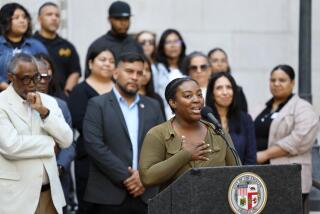Participation in State’s New Workfare Program Lags
- Share via
SACRAMENTO — Fewer welfare recipients than expected are participating in the state’s new workfare program, in part because many of them already are working part time in an effort to become self-supporting, according to a study released Wednesday.
Only 34% of the welfare recipients who registered for workfare during the six-month study period actually participated in any of the education, training or work elements of the program, according to the study conducted for the state by the Manpower Demonstration Research Corp.
Judith Gueron, president of the New York-based research firm, concluded that state officials should expect that at best only about 50% of eligible welfare recipients will end up taking part in the workfare program, known formally as Greater Avenues for Independence (GAIN).
“It will be important to have realistic expectations,” Gueron said. “Because people leave welfare all the time, get part-time jobs, or meet other program criteria, not all welfare recipients targeted by these programs will participate in them.”
Under state and federal law, welfare recipients are permitted to work while receiving public assistance and their welfare checks are partially reduced, depending on how much they earn. A welfare recipient who works at least 15 hours a week is not required to participate in GAIN.
Indeed, 26% of all the aid recipients in the study were exempted from workfare because they had part-time jobs. Another 18% left the welfare rolls before they ever took part in GAIN, while 22% never got involved in the program for reasons county officials could not explain.
State officials initially had hoped that well over 50% of those eligible would participate in GAIN.
Gueron cautioned that the study is based on early efforts to implement the program in eight counties that were among the first to start, including Ventura, Fresno, Kern, Napa and Santa Clara. The study focused on welfare recipients assigned to the program from December, 1986, to June, 1987. Their progress was then tracked through 1988.
The study, the most detailed analysis to date of the GAIN program, takes on added importance because a new federal law will require all states to undertake similar programs designed to give welfare recipients education and put them to work.
California’s program, the most complex in the nation, was approved in 1985 as a result of a bipartisan compromise. Under GAIN, able-bodied welfare recipients with children over the age of 6 will lose their grants unless they choose from an array of educational, training and work programs.
State officials are now preparing for changes in the GAIN program wrought by the new federal law. Most important is a reduction in the age threshold that will require welfare parents with children between the ages of 3 and 5 to enroll in workfare.
California’s landmark workfare program was approved by the Legislature and Gov. George Deukmejian in 1985. All 58 counties in the state are now operating some form of GAIN program.
One fundamental conclusion of the research group’s report was that all of the first eight counties studied had been successful in gearing up for the program and establishing the necessary educational, job training and work programs.
“We accomplished a lot of things people were not sure we could pull off,” said Kathy Lewis, who oversees the GAIN program for the state Department of Social Services.
The study illustrates that GAIN’s record compares favorably with a less-sophisticated workfare program championed in the early 1970s by then-Gov. Ronald Reagan that fell flat on its face when counties throughout the state refused to implement it.
As of February, 1989, 127,000 welfare recipients throughout California have signed up to participate in GAIN, Lewis said. Of these, 38,000 have gotten jobs, including 11,000 who have moved entirely off the welfare rolls.
More to Read
Sign up for Essential California
The most important California stories and recommendations in your inbox every morning.
You may occasionally receive promotional content from the Los Angeles Times.













